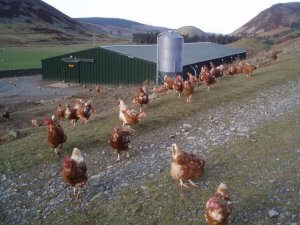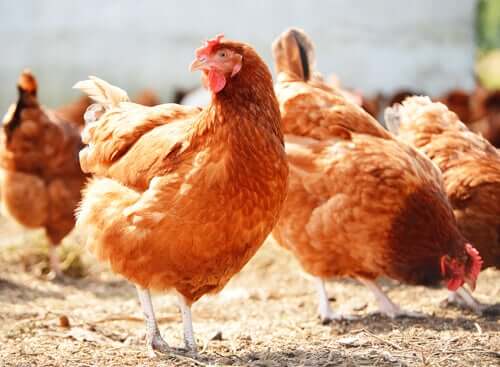All About Pecking Order in the Hen House


Written and verified by the lawyer Francisco María García
A hen house is primarily a space for raising hens and roosters in order to take advantage of their meat and eggs. The pecking order of a hen house is the result of the interaction between its inhabitants.
The difference between a rooster and a hen, besides their sex, has to do with the size of their bodies and crests. Another characteristic that separates the two is the presence or lack of spurs.
As a result of the intervention of human beings, hens gradually lost their ability to fly.
These birds established complex group dynamics both out in the wild as well as in hen houses. In each of these settings, they all know their place in the collective stratification. Once a group of hens and roosters establishes a hierarchy, they can all live in harmony.
In the wild, these birds can live to reach the age of 10 to 15 years. However, as a result of their industrialization for mass consumption, there are few specimens that actually reach such a mature age.
How does the pecking order of a hen house develop?
Roosters and hens always establish a hierarchy among the inhabitants of their hen house. This hierarchy determines rank among the birds, even if they are in cages. Therefore, every new inhabitant will have to fight for his or her place in the pyramidal social construction.

If there’s only one rooster living in a hen house, then he will be at the top of the pecking order. There’s no debate about this. The hens will immediately be a step down in rank.
However, if a hen house has no rooster at all, then it will be up to the hens to determine their own pecking order. They compete for ranks by pecking one another, and fights can vary from mild to fierce.
The battle for leadership chicken coop hierarchies
As you can guess, the more hens there are living together, the longer it will take to complete the structurization process of the hen house’s pecking order.
It’s best not to get in the middle of the fights between the inhabitants of a hen house. Except in extreme cases, for example, when there is a violent attack against one hen in particular. Intervening in the hierarchical structure is not the best idea.
Once the hierarchical process is complete, after battle after battle between successive winners, the chickens will establish order, and there’ll be peace and harmony.
This harmony may become altered if a new fowl joins the group or if one must leave the corral. If that’s the case, then a new pecking order process will have to take place in the hen house. This doesn’t happen with roosters and hens alone. Actually, there are several groups in nature that carry out the practice of developing a hierarchy.
Territorial animals
Hens and roosters are very territorial animals. This is exactly what drives them to develop such a detailed hierarchical system.
Based on the characteristics of their heads, they are able to recognize one another. They are also able to learn from the successes and failures of other members of the group. Each member invariably dominates another and they are the birds that establish these patterns for carrying out determined tasks.
It’s also good to point out the ability that these animals have to communicate with one another. They do so through a variety of vocalizations that serve to warn the rest of the group regarding different situations and dangers. For example, the arrival of food or the appearance of some sort of risk or predator.
Roosters
There are four different types of roosters:

- Dominant Cordial: These are roosters that have grown up without exposure to mistreatment and stressful situations. They are fair, intelligent, and know when and how to intervene depending on the circumstances.
- Dominant Hostile: With a wild disposition, these roosters are aggressive. Their lives consist of dominating other group members through violence. This means they are used to not receiving attacks from other fowl. Therefore, when they are the object of an attack during combat, they are overcome by panic and run away.
- Cordial Submissive: These birds are not very trusting and are in second-to-last place in the chicken coop pecking order. They carry trauma from a very young age, having received fierce attacks by those at the top of the hierarchy. They tend to be very vigilant or else they end up being eliminated by stronger group members.
- Hostile Submissive: These birds develop a great sense of mistrust and are at the bottom of the ranks. They are accustomed to being the target of constant violence from other group members. As a result, they develop a shy existence and set themselves apart from the rest of the flock, approaching to eat only when the rest have finished. It’s not uncommon for the higher ranks to eliminate these members.
Hen houses
It’s important for hen houses to have enough space to allow chickens to avoid overexposure to violent situations. These birds need spaces that allow them to walk and eat in relative freedom. This way, the conditions will minimize confrontations over space.
Source of images: Adam Ward and Guam
A hen house is primarily a space for raising hens and roosters in order to take advantage of their meat and eggs. The pecking order of a hen house is the result of the interaction between its inhabitants.
The difference between a rooster and a hen, besides their sex, has to do with the size of their bodies and crests. Another characteristic that separates the two is the presence or lack of spurs.
As a result of the intervention of human beings, hens gradually lost their ability to fly.
These birds established complex group dynamics both out in the wild as well as in hen houses. In each of these settings, they all know their place in the collective stratification. Once a group of hens and roosters establishes a hierarchy, they can all live in harmony.
In the wild, these birds can live to reach the age of 10 to 15 years. However, as a result of their industrialization for mass consumption, there are few specimens that actually reach such a mature age.
How does the pecking order of a hen house develop?
Roosters and hens always establish a hierarchy among the inhabitants of their hen house. This hierarchy determines rank among the birds, even if they are in cages. Therefore, every new inhabitant will have to fight for his or her place in the pyramidal social construction.

If there’s only one rooster living in a hen house, then he will be at the top of the pecking order. There’s no debate about this. The hens will immediately be a step down in rank.
However, if a hen house has no rooster at all, then it will be up to the hens to determine their own pecking order. They compete for ranks by pecking one another, and fights can vary from mild to fierce.
The battle for leadership chicken coop hierarchies
As you can guess, the more hens there are living together, the longer it will take to complete the structurization process of the hen house’s pecking order.
It’s best not to get in the middle of the fights between the inhabitants of a hen house. Except in extreme cases, for example, when there is a violent attack against one hen in particular. Intervening in the hierarchical structure is not the best idea.
Once the hierarchical process is complete, after battle after battle between successive winners, the chickens will establish order, and there’ll be peace and harmony.
This harmony may become altered if a new fowl joins the group or if one must leave the corral. If that’s the case, then a new pecking order process will have to take place in the hen house. This doesn’t happen with roosters and hens alone. Actually, there are several groups in nature that carry out the practice of developing a hierarchy.
Territorial animals
Hens and roosters are very territorial animals. This is exactly what drives them to develop such a detailed hierarchical system.
Based on the characteristics of their heads, they are able to recognize one another. They are also able to learn from the successes and failures of other members of the group. Each member invariably dominates another and they are the birds that establish these patterns for carrying out determined tasks.
It’s also good to point out the ability that these animals have to communicate with one another. They do so through a variety of vocalizations that serve to warn the rest of the group regarding different situations and dangers. For example, the arrival of food or the appearance of some sort of risk or predator.
Roosters
There are four different types of roosters:

- Dominant Cordial: These are roosters that have grown up without exposure to mistreatment and stressful situations. They are fair, intelligent, and know when and how to intervene depending on the circumstances.
- Dominant Hostile: With a wild disposition, these roosters are aggressive. Their lives consist of dominating other group members through violence. This means they are used to not receiving attacks from other fowl. Therefore, when they are the object of an attack during combat, they are overcome by panic and run away.
- Cordial Submissive: These birds are not very trusting and are in second-to-last place in the chicken coop pecking order. They carry trauma from a very young age, having received fierce attacks by those at the top of the hierarchy. They tend to be very vigilant or else they end up being eliminated by stronger group members.
- Hostile Submissive: These birds develop a great sense of mistrust and are at the bottom of the ranks. They are accustomed to being the target of constant violence from other group members. As a result, they develop a shy existence and set themselves apart from the rest of the flock, approaching to eat only when the rest have finished. It’s not uncommon for the higher ranks to eliminate these members.
Hen houses
It’s important for hen houses to have enough space to allow chickens to avoid overexposure to violent situations. These birds need spaces that allow them to walk and eat in relative freedom. This way, the conditions will minimize confrontations over space.
Source of images: Adam Ward and Guam
This text is provided for informational purposes only and does not replace consultation with a professional. If in doubt, consult your specialist.








